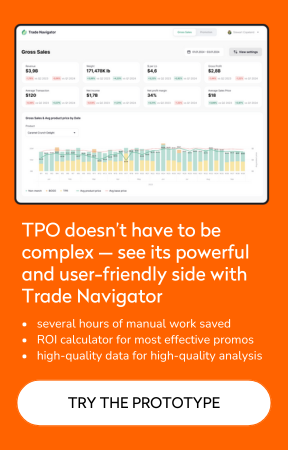
Achieve high ROI and top your profits with trade promotion optimization
Summarize:
Imagine:
- accurately predicting how a promotion will impact sales before you launch it
- targeting the right customers with the right products to reach your next promo’s KPIs
- finding the perfect pricing sweet spot to drive maximum revenue increase
This level of accuracy and skill is often out of reach because traditional trade promotion methods are manual, fragmented, and rely on limited data. Yet, much of your untapped data can actually transform into powerful prediction tools.
Trade promotion optimization (TPO) unlocks this potential. By automating your processes and using all the data your company has generated up to this point, TPO solutions give you those predictive insights and strategic clarity:
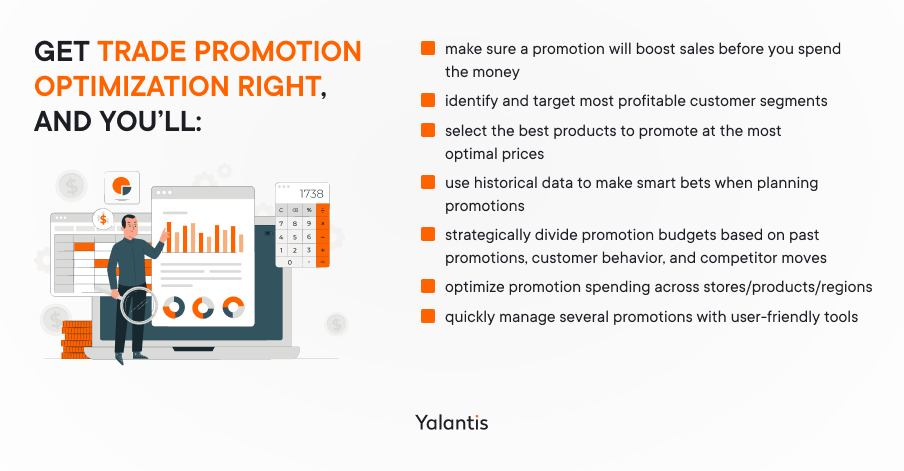
Continue reading to:
- get answers to four key questions that illuminate the power of TPO, e.g., what are its real-life benefits (increase in net sales and no poor performing promotions, anyone?)
- see the one must-have for TPO software that ensures efficient work?
- explore how one TPO solution can help you transform your initial promotion management challenges into advantages
- discover a flowchart to help you select the right TPO tool for your business
What is trade promotion optimization?
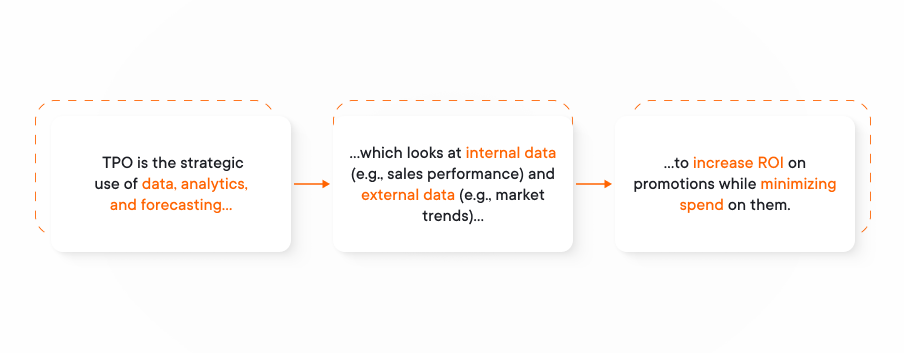
Trade promotion optimization is the strategic use of data, analytics, and forecasting to increase trade promotions’ efficiency and profitability. It looks at both internal and external data:
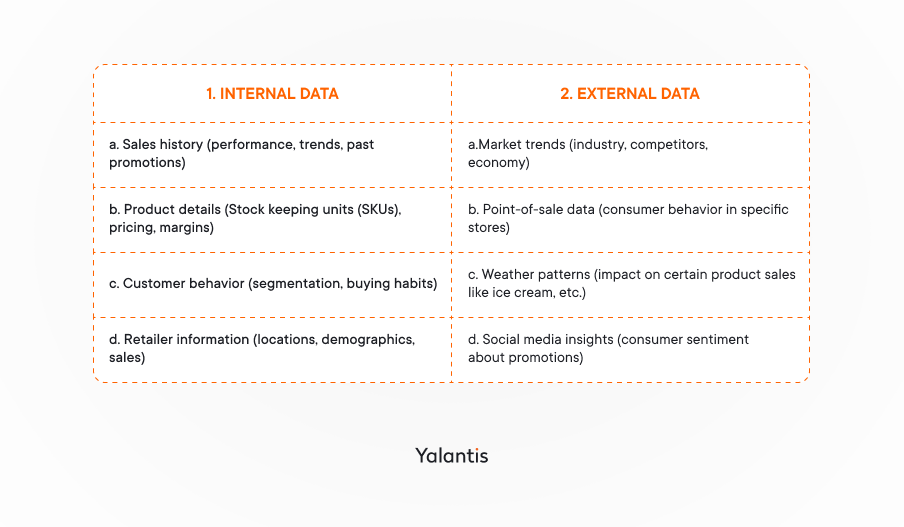
Consumer packaged goods (CPG) companies (like PepsiCo and Nestlé) can maximize the value of every dollar spent on trade promotions through TPO activities. TPO helps such businesses achieve two major goals:
1. highlight which promotions would drive the highest sales and best ROI
2. avoid wasted spending on promotions that don’t align with customer or market trends
How trade promotion optimization works
TPO consists of several critical steps:
- Goal setting and constraints management. To make the most of your TPO strategy, it’s essential to define what you expect to achieve or solve with this solution. For instance, your goals could be:
- improve trade investment ROI
- increase revenue
- eliminate inefficient trade activities
- improve the productivity of the trade promo department
- test product demand
- transition from Excel spreadsheets for better visibility and accuracy of trade spend
- Data integration. To create customized trade promotion strategies, you’ll need to integrate internal and external data into a single source of truth that is easily accessible. For increased accuracy, TPO solutions might need both structured and unstructured data, and it’s crucial to ensure your data storage system is flexible enough to support data of different volumes and formats.
- Data cleansing. The next step is to improve the quality of your data by mitigating errors, aligning data formats, identifying missing values, and detecting outliers. The higher quality of your data, the better outcome you’ll get from your TPO strategy.
- Data analytics. Using business intelligence, artificial intelligence, machine learning, and data science techniques, TPO solutions provide prescriptive and predictive modeling that helps you evaluate the true potential of your trade promotions before allocating budget.
- Continuous adjustment. By adopting a continuous improvement approach to your TPO, you’ll get accurate forecast outcomes relevant to your current business priorities and goals.
While TPO helps you design the best possible promotions, there’s another crucial piece of the puzzle: smoothly managing those promotions.
What is trade promotion management?
Trade promotion management is a comprehensive operational process of planning, organizing, executing, and monitoring trade promotions. Such solutions may include the following features: promotion and budget planning, invoicing, and promotion tracking. Many CPG brands have TPM systems and might feel reluctant to implement TPO, as they believe trade promotion management is enough.
According to the recent survey conducted by the Promotion Optimization Institute, among the top five reasons that prevent CPG companies from implementing trade promotion optimization analytics capabilities into their TPM system are:
- people, time, and resources
- budget and costs
- proper data cleansing and harmonization
- organizational readiness
- change management
TPM software can be a self-sufficient solution to plan and track promotions. However, without additional analytical capabilities, TPM systems lack valuable insights and trade spend optimization algorithms that can help you improve business decision-making and reduce operational expenses.
Core principles of the trade promotion management
Typically, TPM includes the following components:
- Trade planning. TPM software allows retailers to plan their promotions a year in advance. They can build a promotional performance calendar with scheduled promotions that run automatically.
- Promo execution. Creating, updating, editing, and deleting promotions within a TPM system is crucial.
- Budget management. Planning finances and allocating resources efficiently allows you to monitor trade spend, sales data and figures, and revenue, and ensure you stay within your financial goals.
These are basic TPM functions that allow you to shift from trade management in plain spreadsheets to automating and strategizing promo campaigns. Learn in the next chapter how TPM and TPO can work in sync to help you maximize ROI from your trade promotions.
The difference between trade promotion management and optimization
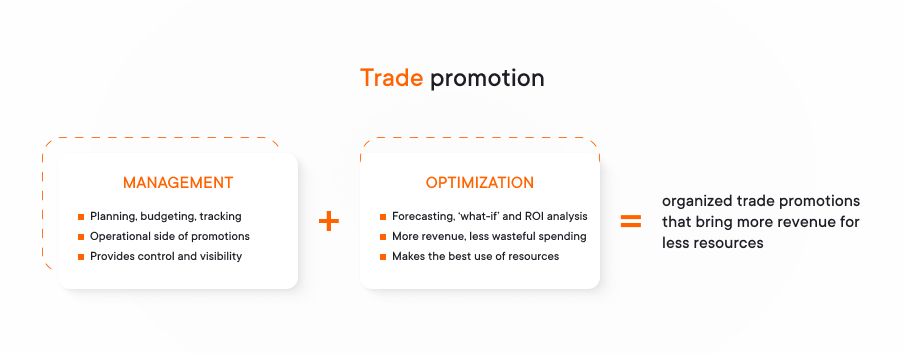
TPO features are usually a part of a larger trade promotion management (TPM) tool.
Think of both activities like this:
- TPM is the engine. It handles the mechanics of setting up, running, and tracking/evaluating trade promotions.
- TPO is an intelligent navigator. It analyzes past promotions, predicts future outcomes, and helps increase promotional effectiveness.
In short, TPM manages the ‘how,’ and TPO focuses on the ‘why’ and ‘what if’ to optimize spend and bring the best promotion results. Combine them both, and your company will be among those that see transformative results —
→ increase in net sales
→ no poor performing promotions
→ improved forecasting
Let’s see more.
Why CPG businesses need TPO: The latest research shows proven benefits
How about we skip the dry, generic advantages here?
Instead, let’s see what trade promotion results and benefits of trade promotion optimization retail and manufacturing companies are getting from optimizing their trade promotion management in 2025. We took the fresh state of the industry report from the Promotion Optimization Institute (POI), which surveyed over 140 CPG companies. Below are the top savings and efficiencies those companies realized from trade promotion management and optimization:
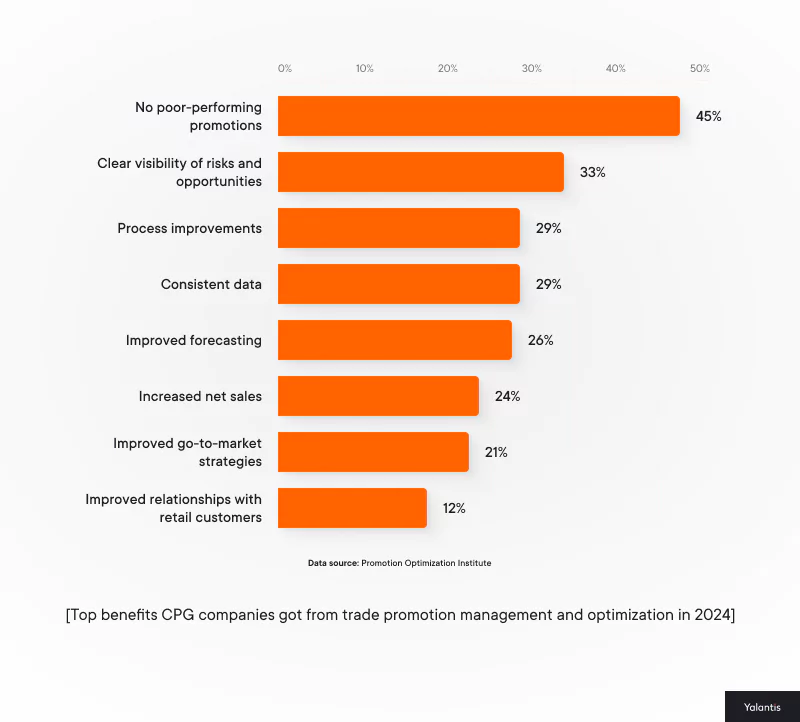
Let’s briefly unpack these gains:
1. Avoiding poor-performing promotions. A forecasting trade promotion optimization model highlights promotions that won’t likely deliver a good return, allowing you to stop them and reallocate budget elsewhere.
2. Clear visibility of promotion hits and misses. Within the TPO software’s dashboards, you can quickly see which promotions are hits that should be expanded and which ones are misses that need to be adjusted.
3. Process improvements that cut manual work. The less time you spend struggling with spreadsheets and disorganized data, the more time you have to brainstorm promotional strategies.
4. Everyone sees the same picture. A single tool for trade promotion management and optimization gets your whole team using the same numbers, making decisions easier and faster.
5. Improved sales forecasting. Trade promotion optimization with machine learning leverages past data and market trends to accurately forecast promotion demand, assess performance potential, identify patterns, and streamline promotion planning.
6. More sales from promotions that work. TPO analyzes past data to identify which specific promotion tactics (discounts, displays, etc.) actually increased sales, so you can focus investments on proven winners.
7. Improved go-to-market strategies. With better visibility into what drives in-store results, your team can design go-to-market plans that are grounded in real performance data, not assumptions. This means smarter timing, better targeting, and tighter alignment between marketing, sales, and retail execution.
8. Collaborative trade promotion planning that benefits both parties. Sharing data-backed promotion insights helps plan tactics that increase sales for your company while also driving foot traffic and revenue generated for retailers.
Not all TPO software will deliver these benefits, though. Find out what works best in the next section.
Well-known trade promotion optimization solutions in the market
Gartner highlights several TPM and TPO solutions that win the market. We’ll review the top three and analyze their pros and cons.
Vividly is a leader among TPM software solutions for the CPG industry. It combines both comprehensive trade promo management and advanced optimization technology. This solution offers real-time forecasting and in-depth trade promotion analysis that allows for building proactive promo strategies.
Pros:
- Quick onboarding and intuitive, easy-to-use interface
- Features for trade planning, deduction management, trade forecasting, budget management, leveraging advanced analytics to generate custom dashboards and reports
- Targeted approach to different user needs, which allows either to implement a TPM system or enhance an exisitng TPM with a TPO solution
- Informative data visualizations and dashboards that show relevant promo results and sales impact
- Public APIs for custom integrations
- Unlimited training programs for internal teams
Cons:
- Tiered pricing models which doesn’t allow users to try all the platform features equally on all tiers
- Limited number of functionality targeted at specific industry use cases
- Lack of integration with ERP systems

Promomash offers comprehensive services for CPG brands, from trade promotion management to deduction and event management. The company’s cloud-based and mobile-friendly solutions provide clients with enhanced scalability, allowing them to run lots of promotions at once.
Pros:
- One system covering different departments’ needs in the CPG company
- Trade spend reporting and promotion performance analytics
- Automated trade promotion optimization planning
- Integration of real-time sales and shipment data into trade analytics
- Flexible subscription plans with the possibility to select suitable services and functionalities
Cons:
- Complex and lengthy onboarding that requires several specialists to complete
- Overwhelming data integration and consolidation process
- High costs for smaller brands
- Glitchy interface and irrelevant features
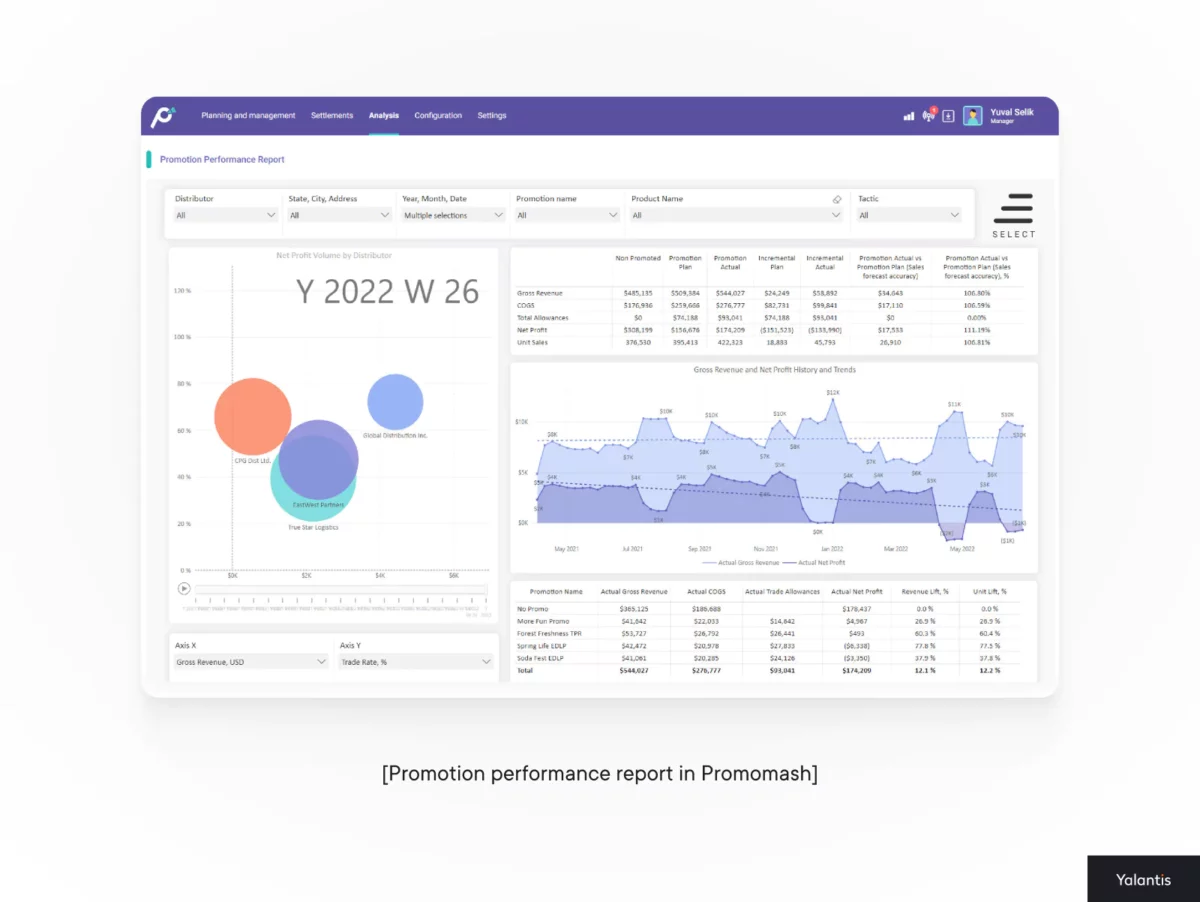
Periscope by McKinsey Advanced Insights provides a cloud-based platform for extracting meaningful insights from big data as part of prescriptive and predictive analytics capabilities, allowing CPG brands to use these insights to improve business decision-making in marketing, sales, and trade promotions. Periscope also helps their clients enhance collaboration with retailers.
Pros:
- End-to-end data management, enrichment, and advanced analytics
- 360-degree customer analytics to define consumer needs
- Marketing and category performance solutions
- Promotion calendar planning
Cons:
- Customizations increase the total cost of ownership (TCO) of the platform
- Costly customizations hinder long-term platform use, as users have to rely on expensive vendor support for even small changes, limiting flexibility
- Difficulties with data collection and interpretation
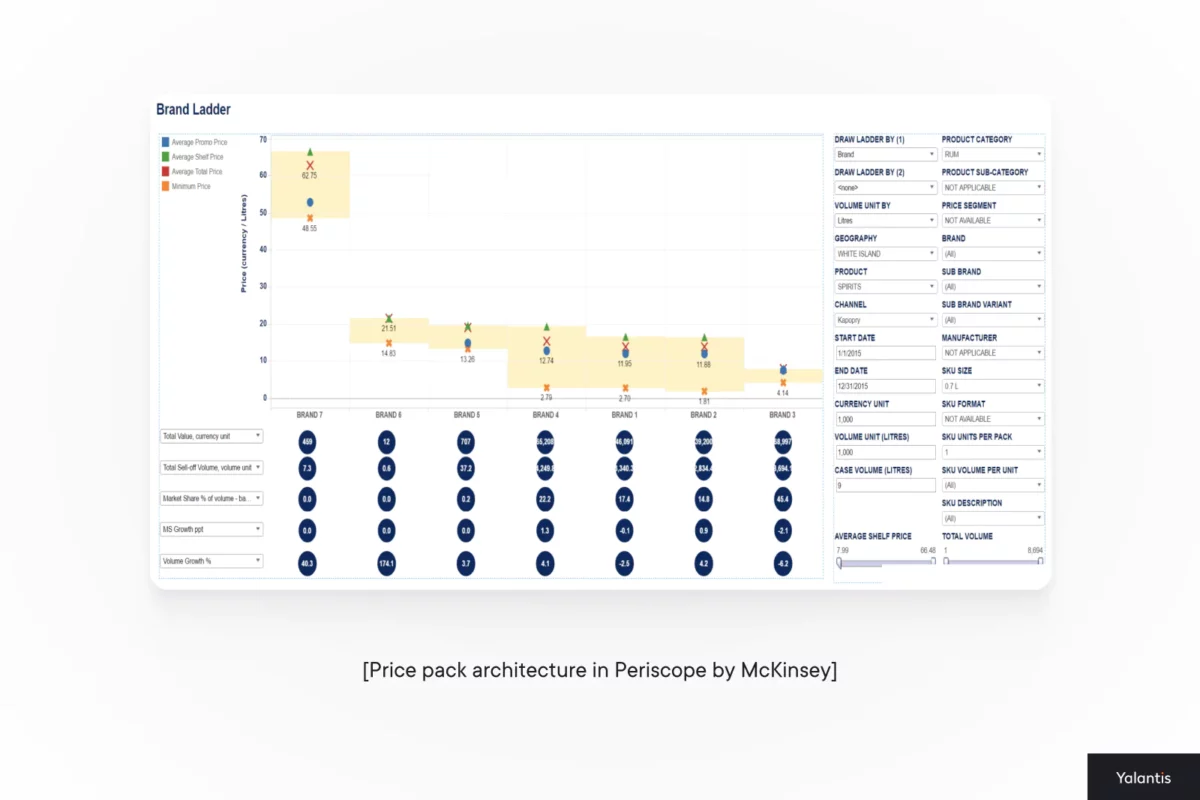
Even though all of the above solutions are the best on the market, they still require you to make certain tradeoffs and agree to limitations. Some systems offer easy onboarding but lack smooth integrations, while others overcomplicate onboarding but provide seamless integration capabilities. Implementing a ready-made TPM/TPO solution may be a short-term win compared to custom development, but if your priority is integrating a solution for long-term use with the highest level of flexibility, consider custom trade promotion optimization software.
Ready-to-use vs custom TPO software: See this decision-making flowchart
If you’re ready to explore solutions, understanding the difference between ready-to-use and custom TPO software is essential. Discover a flowchart for navigating this decision:
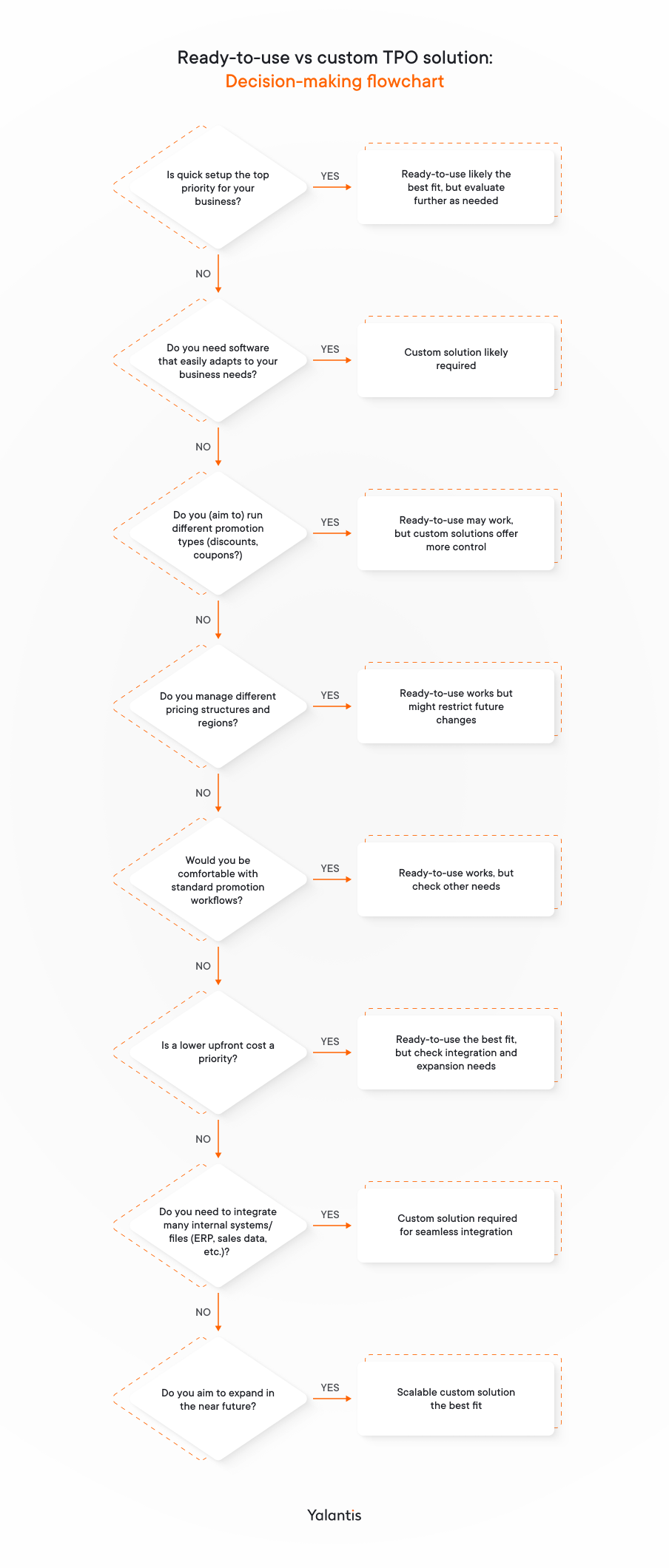
Based on this flowchart, we can highlight the main benefits and limitations of ready-to-use and custom TPM/TPO solutions:
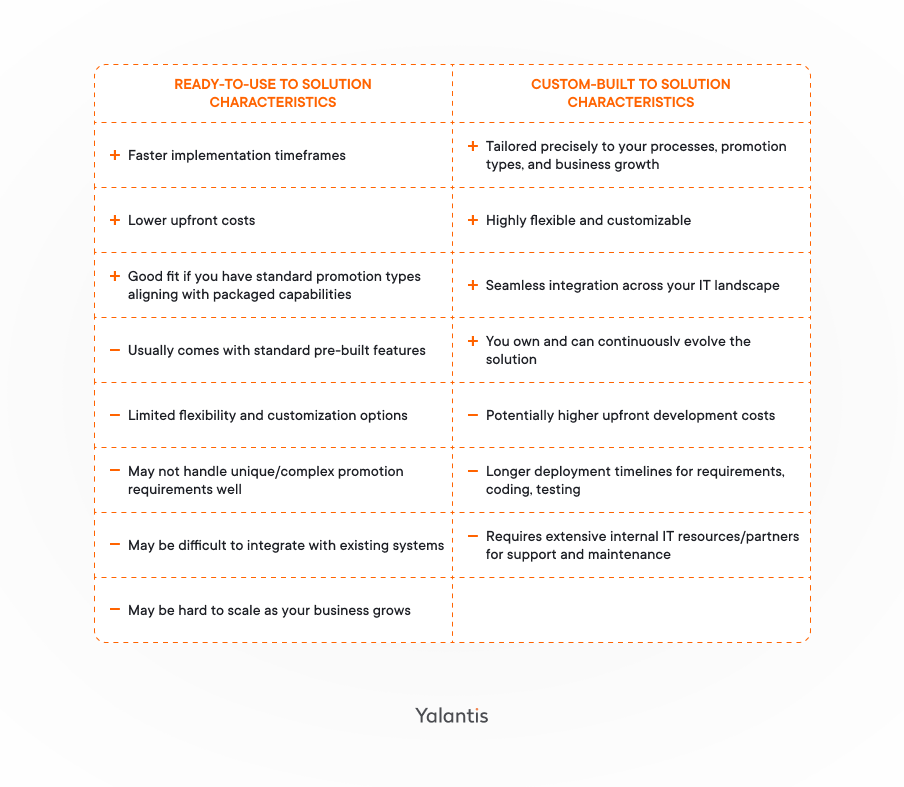
But of course, the strengths and weaknesses of both solution types can leave you with sizable concerns, for example:
- With a generic solution, would you have to change your winning strategies just to fit the software?
- What if you spend a ton getting a ready-to-use solution workable, only to realize down the line that it still won’t do what you really need?
- Custom development can take months. Can you afford to wait that long when your competitors are already optimizing promotions? However, investing time and effort into the development of a tailored solution can help you quickly gain a competitive edge.
- Custom solutions should be more flexible. But what level of customization does your business need?
- Your team may be too used to clunky spreadsheets. Is taking on a new system even worth it? Can you manage that long-term?
With this in mind, what if you could get the quick start of a ready-to-use platform while keeping the freedom to tailor it to your unique needs?
An example of TPO software by Yalantis
A trade promotion management software with TPO capabilities would be the best bet. Since these processes are closely connected, separating them across multiple trade management and trade promotion optimization tools would just eat up your money and time.
Once again, let’s set the dry and generic part aside. Instead, take a look at the key components of a real-life TPM/TPO system that has already delivered results.
We’ll use one of Yalantis’ recent projects for a US food manufacturer and retailer as an example. The result is a custom system that helps this partner manage and improve trade promotions. To deliver an efficient solution, the Yalantis team:
- performed extensive market research
- analyzed user feedback
- studied the requirements for effective promotion optimization
- consulted with industry experts
- conducted user testing and iterations
As a result, this system allows a food manufacturer and retailer to reduce costs, make profitable and data-driven decisions based on internal and external data, and avoid spreadsheet chaos.
Here are its main features:
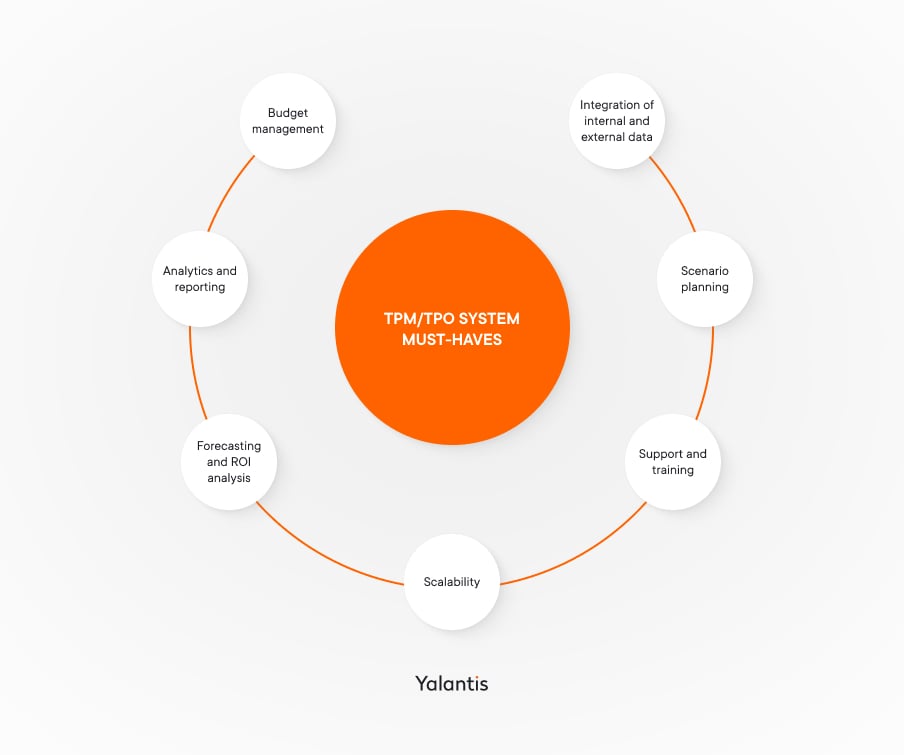
- Data integration from multiple sources — the system collects inventory data from the client’s ERP, sales/operations data from Excel files, and competitive insights from third-party providers.
- Budget management with automation — pre-filled budgeting templates use historical data. It intelligently allocates budgets to maximize returns while automating processes to save time.
- Data analytics and reporting made clear — sales dashboards show real-time sales metrics, identify trends, and promotion performance. Separate dashboards use artificial intelligence (AI) to analyze seasonal demand, pricing trends, and competition.
- Forecasting and ROI calculator — the system forecasts promotion success and returns using an ROI calculator, machine learning demand planning and forecasting, and budget optimization engines.
- Scenario planning — the software enables fine-tuning promotions by location, product, and season for accurate forecasting and adjustment of production volumes, pricing strategies, and inventory levels.
- Enablement through training — comprehensive support and training like demos and Q&As helped drive software adoption by manufacturing and retail teams resistant to new processes.
- Scalability for business growth — the flexible system can scale to handle the client’s expansion into new regions and onboarding of more employees.
Want to experience these features to improve your own promotion performance?
Get your success planSo say you’ve got a tool for trade promotion management. Let’s stick to our approach of practical results and see how this tool can transform key TPM/TPO challenges into advantages.
Challenges TPO solutions help you solve: Yalantis Trade Navigator
Based on the custom TPM/TPO system project above, Yalantis has created a productized offering called Trade Navigator. Having delivered 5 customized solutions to CPG companies, we have an in-depth understanding of the key challenges companies face in this industry, and Trade Navigator is purposefully designed to help solve them.
TPO solutions like Yalantis Trade Navigator combine TPM and TPO capabilities into a unified platform. The Yalantis team can quickly customize it to unique business demands and help you transform initial challenges into advantages:
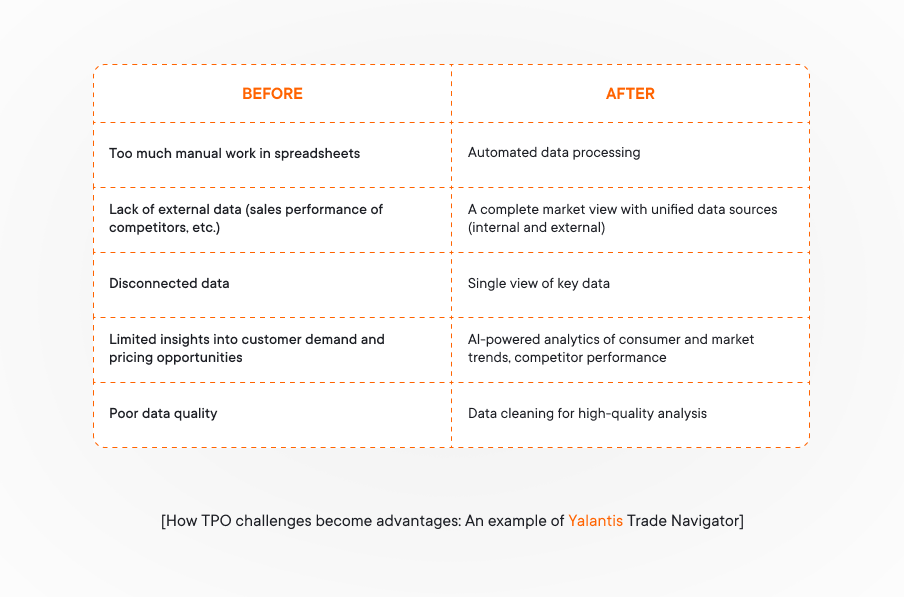
As such, you can avoid:
- too much manual work. Trade Navigator removes the need to manually enter and retrieve data in spreadsheets. It automatically collects all key sales and trade promotion operations data in one place. The Yalantis team also handles all data-related tasks for setting up and running Trade Navigator: data extraction, cleaning, transforming — you know, all that “fun” data work. This frees up our clients to focus on more exciting tasks like hunting down the next big promotion idea.
- lack of external data analysis. To develop effective promotional plans, companies need to analyze external factors beyond their own data — like competitor sales volume, market trends, and even weather impacts for seasonal products. Trade Navigator integrates both internal company data and external data sources (e.g., sales statistics across the country), providing a complete market view.
- disconnected data. Having separate systems for promotions, sales, inventory and other data makes it hard to get a clear unified picture. Trade Navigator consolidates all this critical information into a single view.
- ineffective pricing strategies. Finding prices that boost revenue without offering huge discounts is tricky. Trade Navigator includes trade promotion forecasting tools to predict demand during promotional activities. This helps plan supply chain, production, inventory and logistics to optimally meet that demand.
- poor data quality. High-quality data means high-quality analysis. As such, when customizing Trade Navigator to unique business needs, Yalantis data team cleans and integrates the client’s data to enhance its quality before feeding it into the tool.
Launch a custom TPO solution with Yalantis
Some facts for you to get familiar with Yalantis Trade Navigator:
- an accelerator Yalantis team can deploy for your which saves time and costs on development
- ensures that the customer retains ownership of the intellectual property forever, with stable minimum running costs (excluding infrastructure)
- can seamlessly integrate with both internal and external data sources
- can scale as your business and user base grows
- has a learning curve, with products demos and Q&A sessions
Want more details? Request trade promotion optimization consulting from our data experts and a quick but comprehensive demo. They will show you how Yalantis can tailor the Trade Navigator to your business needs.
Experience the perfect blend of speed, simplicity, and customization and run promotions that top your sales targets.
Get a Trade Navigator demoFAQ
What are the KPIs for trade promotion optimization?
Core key performance indicators include:
- Incremental sales lift: Sales boost the promotion caused.
- Return on Investment (ROI): Net profit from the promotion divided by its cost. Positive ROI means the promotion was profitable.
- Promotion profit: Total profit from the promotion, including both the extra sales and the cost of the discount.
- Baseline sales: How much you usually sell without a promotion. This gives you a benchmark to measure the promotion’s impact.
- Market share: The portion of the market your product owns. Promotions can aim to increase this share.
How does TPO support collaboration between manufacturers and retailers?
TPO tools provide a shared, data-driven foundation for planning joint promotions. Instead of relying on guesswork or siloed reports, both manufacturers and retail partners can:
- review historical performance
- predict trade promotions and expected outcomes
- align on strategies that benefit both sides
Such transparency helps build trust, improves negotiation outcomes, and ensures promotions are well-timed, well-funded, and mutually profitable.
Are there any trade promotion optimization algorithms?
Yes! TPO algorithms often use machine learning techniques to continuously improve and adapt strategies based on real-time data and feedback. They use a variety of data, like:
- past sales records
- promotion plans
- prices
- how much product you have on hand
- competitor activity
- market trends
These algorithms help you optimize your trade promotions, creating the best possible promotion plans to increase sales, make more money, and lower costs.
Rate this article
4.9/5.0
based on 9 reviews



